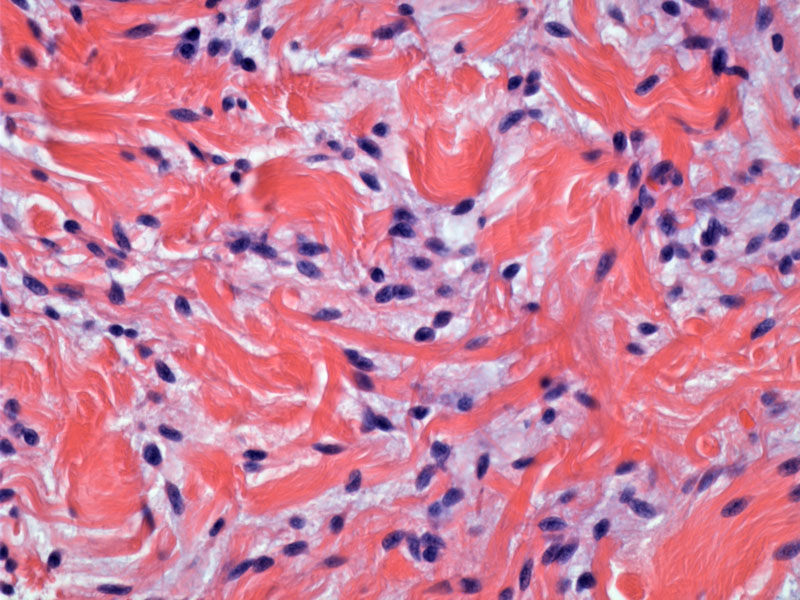

Case 1 - Collagenized stroma admixed with small ovoid spindle cells are characteristic features. In a spindle cell predominant lipoma, the adipocytic component may be minimal.
Case 2 - Mature adipocytes, uniform spindle cells, and collagen bundles and/or fibers are present in varying proportions. A myxoid matrix may be encountered in some cases.
Variable amounts of stroma with spindle cell population. The spindle cells have very bland elongated nuclei.
The spindle cells stain for CD34. While CD34+ spindle cells are seen in this lesion, they are also seen in a variety of other adipocytic lesions including lipoma, angiolipoma, angiomyolipoma, intramuscular lipoma, and well-differentiated lipoma-like liposarcoma (Suster)
Case 3 - This case had plentiful multinucleated giant cells with nuclei in a floret arrangement.
Case 4: This particular case had numerous mast cells, a common finding in spindle cell lipomas.
A closer look at the mast cells.
Spindle cell and pleomorphic lipoma are considered variants of a single entity and are often described together as "spindle cell/pleomorphic lipoma". By definition, these neoplasms must arise in the superficial soft tissues i.e. subcutis or occasionally dermis. Deeper lesions are most likely atypical lipomatous tumors that carry a risk of recurrence and dedifferentiation.
Grossly, the tumor is a firm well circumscribed mass. Histologically, there is a characteristic blend of mature adipocytes, spindle cells and scattered brightly pink ropy collagen fibers. Pleomorphic lipomas contain, in addition, multinucleated giant cells that have a "floret" ring-like arrangement of their nuclei.
The main entity on the differential is well-differentiated liposarcoma/atypical lipomatous tumor. Careful examination for lipoblasts (which may be occasionally present in pleomorphic lipomas), atypia as well as clinical correlation with the location of the mass are distinguishing features.
Spindle cell and pleomorphic lipomas consistently contain chromosomal abnormalities in 13q and 16q, whereas atypical lipomatous tumors exhibit ring chromosomes derived from the long arm of chromosome 12 (Fletcher).
Spindle cell predominant lipomas may appear similar to schwannomas, but the spindle cells are S-100 negative and CD34 positive (Suster, Folpe). Myxoid change may be prominent in the stroma, leading to confusion with myxoid liposarcoma, however, the plexiform "crow's feet" vascular network seen in myxoid lipoma is usually lacking and cellular atypia is minimal (Fletcher).
Striking predilection for males (M:F ratio of 10:1) with a peak incidence in the 4th and 5th decades. The mass is slow growing, mobile and painless. Unlike ordinary lipomas which arise in the trunk and proximal limbs, most spindle cell/pleomorphic lipomas arise in the posterior neck or upper back (Folpe, Fletcher).
Local excision is curative.
Spindle cell and pleomorphic lipomas consistently contain chromosomal abnormalities in 13q and 16q
Spindle cell lipomas show a male predilection and often involve the posterior neck/ upper back
• Lipomatous : Pleomorphic Lipoma
Fletcher CDM, ed. Diagnostic Histopathology of Tumors. 3rd Ed. Philadelphia, PA: Elsevier; 2007: 1532-3.
Folpe AL, Inwards CY. Bone and Soft Tissue Pathology: Foundations in Diagnostic Pathology Philadelphia, PA: Elsevier; 2010: 101-3.
Suster S, Fisher C.Am J Surg Pathol. Immunoreactivity for the human hematopoietic progenitor cell antigen (CD34) in lipomatous tumors. 1997 Feb;21(2):195-200.